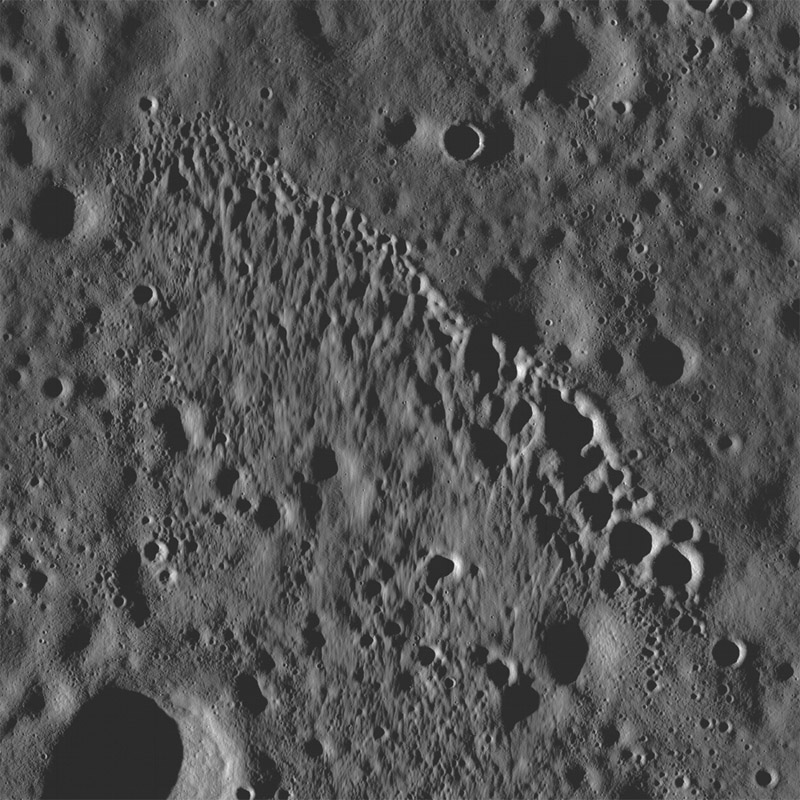Difference between revisions of "August 9, 2009"
| Line 6: | Line 6: | ||
<em>image from [http://lroc.sese.asu.edu/news/?archives/83-Stream-of-Secondary-Craters.html LROC News System], NASA - ASU</em><br /> | <em>image from [http://lroc.sese.asu.edu/news/?archives/83-Stream-of-Secondary-Craters.html LROC News System], NASA - ASU</em><br /> | ||
<br /> | <br /> | ||
| − | We understand secondary craters. Material thrown out during the formation of a primary crater includes fractured and broken rocks that follow a relatively low speed and low angle ballistic path away from the primary. When the collection of debris intercepts the ground it forms a string of closely spaced, often touching, smaller, less circular craters. Rock fragments and powder wrap around the rims of the secondaries, depositing vees of material that point back toward their primary. This newly released [http://lroc.sese.asu.edu/news/?archives/83-Stream-of-Secondary-Craters.html image] from the Lunar Reconnaissance Orbiter is interpreted by the LRO team as a secondry chain, probably originating from the formation of the young crater Giordano Bruno, 525 km to the north. The trail of craters is about 4.5 km long and the largest crater is 340 m wide. Many secondary chains (as exemplified by the [http://wapi.isu.edu/geo_pgt/Mod06_Moon_a_b/a1706x.htm ones] north of Copernicus) have their largest craters nearest the primary; this chain doesn't. It is also very curious that there is a faint lineated texture that extends below the line of the chain. In some places the image seems strangely out of focus in this region of apparent non-radial flow. Perhaps the source crater was not Giordano Bruno to the northwest, but some other crater to the southeast? However, the high degree of preservation of the secondary chain is consistent with Giordano Bruno, which is one of the [http://lpod. | + | We understand secondary craters. Material thrown out during the formation of a primary crater includes fractured and broken rocks that follow a relatively low speed and low angle ballistic path away from the primary. When the collection of debris intercepts the ground it forms a string of closely spaced, often touching, smaller, less circular craters. Rock fragments and powder wrap around the rims of the secondaries, depositing vees of material that point back toward their primary. This newly released [http://lroc.sese.asu.edu/news/?archives/83-Stream-of-Secondary-Craters.html image] from the Lunar Reconnaissance Orbiter is interpreted by the LRO team as a secondry chain, probably originating from the formation of the young crater Giordano Bruno, 525 km to the north. The trail of craters is about 4.5 km long and the largest crater is 340 m wide. Many secondary chains (as exemplified by the [http://wapi.isu.edu/geo_pgt/Mod06_Moon_a_b/a1706x.htm ones] north of Copernicus) have their largest craters nearest the primary; this chain doesn't. It is also very curious that there is a faint lineated texture that extends below the line of the chain. In some places the image seems strangely out of focus in this region of apparent non-radial flow. Perhaps the source crater was not Giordano Bruno to the northwest, but some other crater to the southeast? However, the high degree of preservation of the secondary chain is consistent with Giordano Bruno, which is one of the [http://www2.lpod.org/wiki/July_13,_2008 youngest] medium-sized craters on the Moon.<br /> |
<br /> | <br /> | ||
<em>[mailto:tychocrater@yahoo.com Chuck Wood]</em><br /> | <em>[mailto:tychocrater@yahoo.com Chuck Wood]</em><br /> | ||
Latest revision as of 07:24, 28 October 2018
Sideways Ejecta?

image from LROC News System, NASA - ASU
We understand secondary craters. Material thrown out during the formation of a primary crater includes fractured and broken rocks that follow a relatively low speed and low angle ballistic path away from the primary. When the collection of debris intercepts the ground it forms a string of closely spaced, often touching, smaller, less circular craters. Rock fragments and powder wrap around the rims of the secondaries, depositing vees of material that point back toward their primary. This newly released image from the Lunar Reconnaissance Orbiter is interpreted by the LRO team as a secondry chain, probably originating from the formation of the young crater Giordano Bruno, 525 km to the north. The trail of craters is about 4.5 km long and the largest crater is 340 m wide. Many secondary chains (as exemplified by the ones north of Copernicus) have their largest craters nearest the primary; this chain doesn't. It is also very curious that there is a faint lineated texture that extends below the line of the chain. In some places the image seems strangely out of focus in this region of apparent non-radial flow. Perhaps the source crater was not Giordano Bruno to the northwest, but some other crater to the southeast? However, the high degree of preservation of the secondary chain is consistent with Giordano Bruno, which is one of the youngest medium-sized craters on the Moon.
Chuck Wood
Yesterday's LPOD: Partial Part 2
Tomorrow's LPOD: Moon Woman
COMMENTS?
Register, Log in, and join in the comments.



